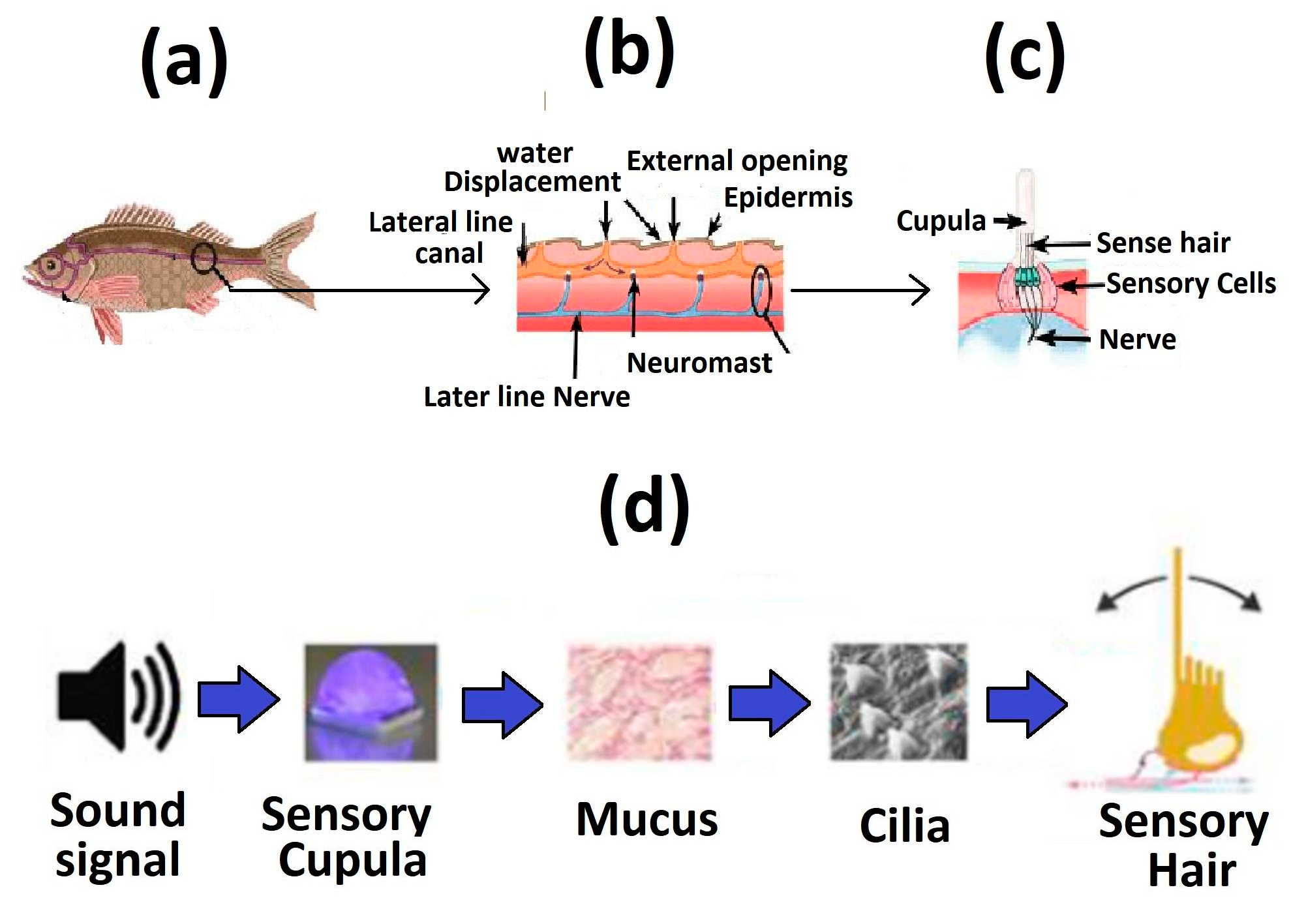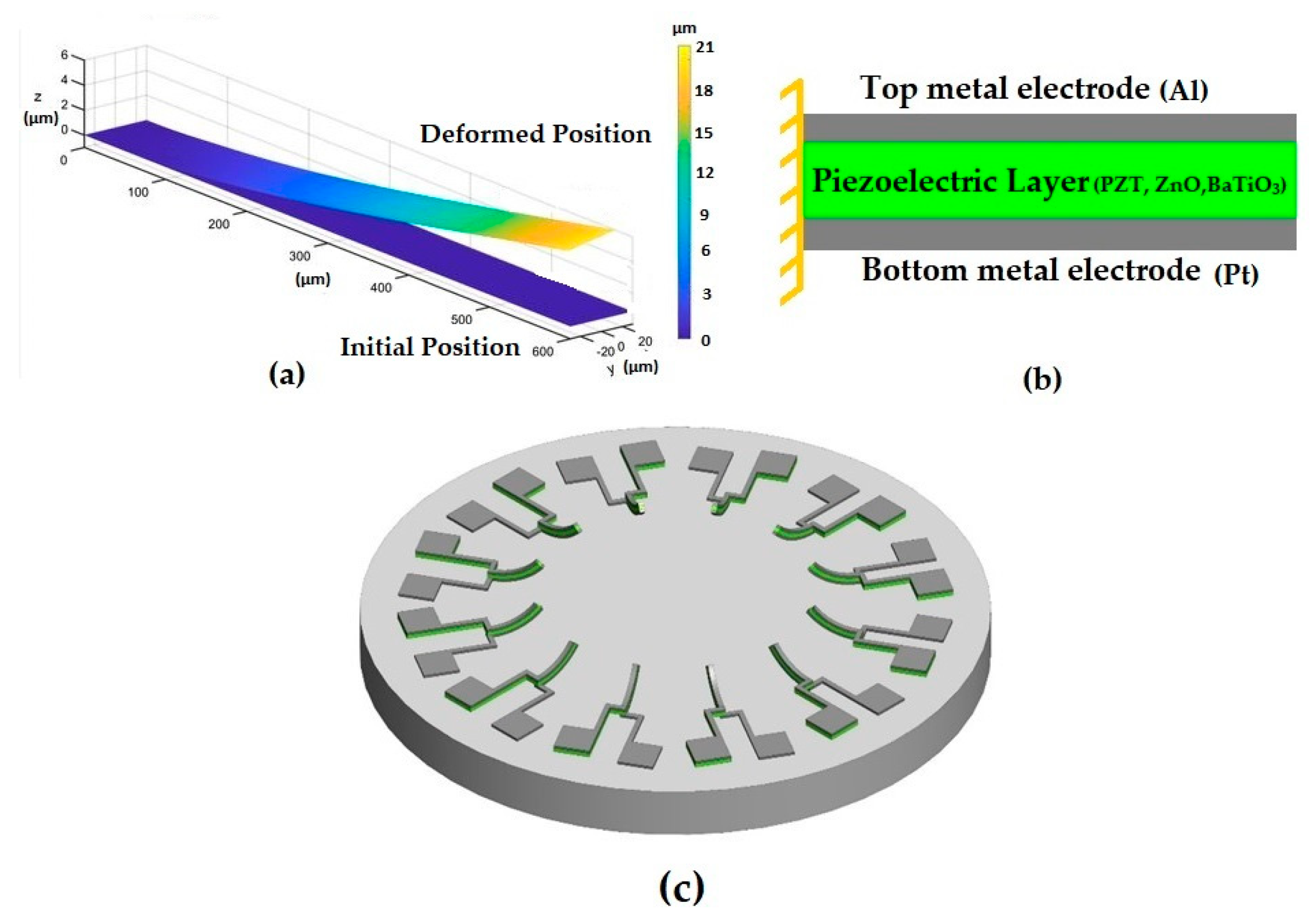Combining COMSOL Modeling with Different Piezoelectric Materials to Design MEMS Cantilevers for Marine Sensing Robotics †
Abstract
:1. Introduction
2. Bionic and Vibration Picking Principle
3. Device Design and Modeling
4. Results
5. Conclusions
Author Contributions
Funding
Institutional Review Board Statement
Informed Consent Statement
Data Availability Statement
Conflicts of Interest
References
- Zhou, Z.-G.; Liu, Z.-W. Biomimetic Cilia Based on MEMS Technology. J. Bionic Eng. 2008, 5, 358–365. [Google Scholar] [CrossRef]
- Han, Z.; Liu, L.; Wang, K.; Song, H.; Chen, D.; Wang, Z.; Niu, S.; Zhang, J.; Ren, L. Artificial Hair-Like Sensors Inspired from Nature: A Review. J. Bionic Eng. 2018, 15, 409–434. [Google Scholar] [CrossRef]
- Coombs, S.; Görner, P.; Münz, H. The Mechanosensory Lateral Line, 1st ed.; Springer: New York, NY, USA, 1989. [Google Scholar] [CrossRef]
- Mogdans, J.; Engelmann, J.; Hanke, W.; Kröther, S. The Fish Lateral Line: How to Detect Hydrodynamic Stimuli; Springer: Vienna, Austria, 2003; pp. 173–185. [Google Scholar] [CrossRef]
- Sane, S.P.; McHenry, M.J. The biomechanics of sensory organs. Integr. Comp. Biol. 2009, 49, i8–i23. [Google Scholar] [CrossRef]
- Guan, L.; Xue, C.; Zhang, G.; Zhang, W.; Wang, P. Advancements in technology and design of NEMS vector hydrophone. Microsyst. Technol. 2011, 17, 459–467. [Google Scholar] [CrossRef]
- Liu, C. Foundations of MEMS; Pearson Education, Inc.: Upper Saddle River, NJ, USA, 2005. [Google Scholar]
- Ramadan, K.S.; Sameoto, D.; Evoy, S. A review of piezoelectric polymers as functional materials for electromechanical transducers. Smart Mater. Struct. 2014, 23, 033001. [Google Scholar] [CrossRef]
- Abdul, B.; Mastronardi, V.; Qualtieri, A.; Guido, F.; Algieri, L.; Rizzi, F.; De Vittorio, M. Design, fabrication and characterization of piezoelectric cantilever MEMS for underwater application. Micro Nano Eng. 2020, 7, 100050. [Google Scholar] [CrossRef]
- Abdul, B.; Mastronardi, V.M.; Qualtieri, A.; Algieri, L.; Guido, F.; Rizzi, F.; De Vittorio, M. Sensitivity and directivity analysis of piezoelectric ultrasonic cantilever-based mems hydrophone for underwater applications. J. Mar. Sci. Eng. 2020, 8, 784. [Google Scholar] [CrossRef]
- Caruso, F.; Alonge, G.; Bellia, G.; De Domenico, E.; Grammauta, R.; Larosa, G.; Mazzola, S.; Riccobene, G.; Pavan, G.; Papale, E.; et al. Long-term monitoring of dolphin biosonar activity in deep pelagic waters of the Mediterranean Sea. Sci. Rep. 2017, 7, 4321. [Google Scholar] [CrossRef] [PubMed]
- Liu, M.; Cui, T.; Dong, W.; Cui, Y.; Wang, J.; Du, L.; Wang, L. Piezoelectric microcantilevers with two with two PZT thin-film elements for microsensors and microactuators. In Proceedings of the 1st IEEE International Conference on Nano/Micro Engineered and Molecular Systems, Zhuhai, China, 19–21 January 2006. [Google Scholar]
- Kordrostami, Z.; Roohizadegan, S. Particle Swarm Approach to the Optimisation of Trenched Cantilever- Based MEMS Piezoelectric Energy Harvesters. IET Sci. Meas. Technol. 2019, 13, 536–543. [Google Scholar] [CrossRef]
- Kashiwao, T.; Izadgoshasb, I.; Lim, Y.Y.; Deguchi, M. Optimization of Rectifier Circuits for a Vibration Energy Harvesting System Using a Macro-Fiber Composite Piezoelectric Element. Microelectron. J. 2016, 54, 109–115. [Google Scholar] [CrossRef]
- Wang, Z.L. Zinc oxide nanostructures: Growth, properties and applications. J. Phys. Condens. Matter 2004, 16, R829. [Google Scholar] [CrossRef]
- Mortet, V.; Nesladek, M.; Haenen, K.; Morel, A.; D’Olieslaeger, M.; Vanecek, M. Physical properties of polycrystalline aluminium nitride films deposited by magnetron sputtering. Diam. Relat. Mater. 2004, 13, 1120–1124. [Google Scholar] [CrossRef]
- Wang, Y.; Yan, J.; Cheng, H.; Chen, N.; Yan, P.; Ouyang, J. Low Thermal Budget Lead Zirconate Titanate Thick Films Integrated on Si for Piezo-MEMS Applications. Microelectron. Eng. 2020, 219, 111145. [Google Scholar] [CrossRef]
- Rockstad, H.K.; Kenny, T.W.; Kelly, P.J.; Gabrielson, T.B. A Microfabricated Electron-Tunneling Accelerometer as a Directional Underwater Acoustic Sensor. Am. Inst. Phys. 2008, 57, 57–68. [Google Scholar] [CrossRef]
- Zhang, G.; Wang, P.; Guan, L.; Xiong, J.; Zhang, W. Improvement of the MEMS Bionic Vector Hydrophone. Microelectron. J. 2011, 42, 815–819. [Google Scholar] [CrossRef]
- Xue, C.; Chen, S.; Zhang, W.; Zhang, B.; Zhang, G.; Qiao, H. Design, Fabrication, and Preliminary Characterization of a Novel MEMS Bionic Vector Hydrophone. Microelectron. J. 2007, 38, 1021–1026. [Google Scholar] [CrossRef]
- Abdul, B.; Abdul, S.; Asary, A.R. Biomimetic Cilia-based MEMS Sensors for Underwater Applications—A Review. N. Am. Acad. Res. 2021, 4, 11–21. [Google Scholar] [CrossRef]
- Calleja, M.; Tamayo, J.; Johansson, A.; Rasmussen, P.; Lechuga, L.M.; Boisen, A. Polymeric cantilever arrays for biosensing applications. Sens. Lett. 2003, 1, 20–24. [Google Scholar] [CrossRef]
- Zhang, X.D.; Sun, C.T. Minimum detectable force gradients of piezoelectric microcantilever. J. Micromech. Microeng. 1995, 5, 231–236. [Google Scholar]



Disclaimer/Publisher’s Note: The statements, opinions and data contained in all publications are solely those of the individual author(s) and contributor(s) and not of MDPI and/or the editor(s). MDPI and/or the editor(s) disclaim responsibility for any injury to people or property resulting from any ideas, methods, instructions or products referred to in the content. |
© 2023 by the authors. Licensee MDPI, Basel, Switzerland. This article is an open access article distributed under the terms and conditions of the Creative Commons Attribution (CC BY) license (https://creativecommons.org/licenses/by/4.0/).
Share and Cite
Abdul, B.; Shibly, M.A.H.; Asary, A.R. Combining COMSOL Modeling with Different Piezoelectric Materials to Design MEMS Cantilevers for Marine Sensing Robotics. Eng. Proc. 2023, 37, 64. https://doi.org/10.3390/ECP2023-14641
Abdul B, Shibly MAH, Asary AR. Combining COMSOL Modeling with Different Piezoelectric Materials to Design MEMS Cantilevers for Marine Sensing Robotics. Engineering Proceedings. 2023; 37(1):64. https://doi.org/10.3390/ECP2023-14641
Chicago/Turabian StyleAbdul, Basit, Mohammad Abul Hasan Shibly, and Abdul Rab Asary. 2023. "Combining COMSOL Modeling with Different Piezoelectric Materials to Design MEMS Cantilevers for Marine Sensing Robotics" Engineering Proceedings 37, no. 1: 64. https://doi.org/10.3390/ECP2023-14641
APA StyleAbdul, B., Shibly, M. A. H., & Asary, A. R. (2023). Combining COMSOL Modeling with Different Piezoelectric Materials to Design MEMS Cantilevers for Marine Sensing Robotics. Engineering Proceedings, 37(1), 64. https://doi.org/10.3390/ECP2023-14641






